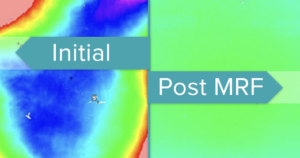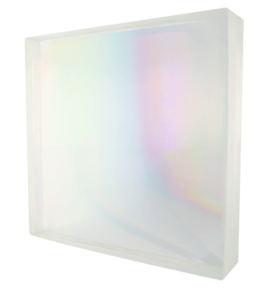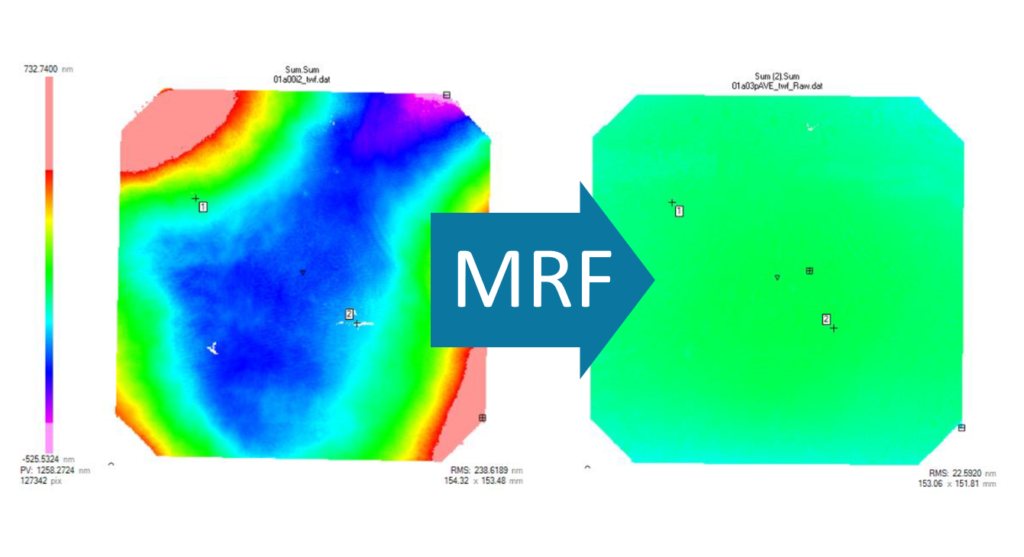 Volume phase holographic gratings (VPHGs) manufactured with dichromated gelatin (DCG) have become a staple of astronomical spectrograph design due to their high first order diffraction efficiency, low stray light, and high index modulation, which enables wide spectral bandwidths and angular tuning. At SPIE Astronomical Telescopes + Instrumentation 2024, we gave a talk on one optical limitation of VPHGs – wavefront error – and how custom magnetorheological finishing (MRF) can be used to mitigate it. Furthermore, we demonstrated the improvement achieved with MRF using an exploratory grating fabricated for the future HARMONI Spectrograph to be deployed at ESO’s Extremely Large Telescope (ELT). Read our summary below:
Volume phase holographic gratings (VPHGs) manufactured with dichromated gelatin (DCG) have become a staple of astronomical spectrograph design due to their high first order diffraction efficiency, low stray light, and high index modulation, which enables wide spectral bandwidths and angular tuning. At SPIE Astronomical Telescopes + Instrumentation 2024, we gave a talk on one optical limitation of VPHGs – wavefront error – and how custom magnetorheological finishing (MRF) can be used to mitigate it. Furthermore, we demonstrated the improvement achieved with MRF using an exploratory grating fabricated for the future HARMONI Spectrograph to be deployed at ESO’s Extremely Large Telescope (ELT). Read our summary below:
Astronomy gratings and wavefront error
In astronomy, large-format VPHGs are manufactured by holographically imaging a periodic structure of varying refractive indices into dichromated gelatin sealed between two optical windows. The encapsulated gratings are highly durable, can withstand cryogenic temperatures, and offer flexibility in covering various spectral ranges. They offer smoothly varying spectral profiles which can be tuned by adjusting the angle of incidence, thereby enabling the design of a range of astronomical spectrographs, from low to high resolution, to address different scientific objectives.
 One important factor in astronomical spectrograph design is wavefront error, which can compromise image quality by distorting the light as it passes through the optical elements. For VPHGs, the most relevant type of wavefront error is the Diffracted Wavefront Error (DWE), which specifically affects the first-order diffracted beam used in spectral observations. This error can result from factors related to the glass substrates, the gelatin layer, and the final processing of the grating. The dominant aberrations observed in VPHGs include power and astigmatism. While conventional polishing techniques can reduce some of these aberrations, they are often insufficient for achieving the very low DWE required for cutting-edge astronomical spectrographs.
One important factor in astronomical spectrograph design is wavefront error, which can compromise image quality by distorting the light as it passes through the optical elements. For VPHGs, the most relevant type of wavefront error is the Diffracted Wavefront Error (DWE), which specifically affects the first-order diffracted beam used in spectral observations. This error can result from factors related to the glass substrates, the gelatin layer, and the final processing of the grating. The dominant aberrations observed in VPHGs include power and astigmatism. While conventional polishing techniques can reduce some of these aberrations, they are often insufficient for achieving the very low DWE required for cutting-edge astronomical spectrographs.
Using MRF to reduce wavefront error on large gratings
To further reduce DWE, we explored the application of magnetorheological finishing (MRF) as a final polishing step. MRF is a computer-controlled polishing process that uses a magnetic-field-stiffened fluid to precisely remove material from optical surfaces. This process provides a level of control and precision superior to conventional polishing methods. To test this approach, Wasatch Photonics collaborated with Oxford University and QED Optics to implement MRF on a large-format VPH grating for the HARMONI spectrograph, which is being designed for the European Southern Observatory’s Extremely Large Telescope (ELT). HARMONI requires gratings with very low DWE to achieve its science objectives, which includes observing a wide range of astronomical phenomena with high sensitivity and spatial resolution.
MRF was applied to an exploratory grating designed for HARMONI at QED Optics, using a custom subaperture stitching interferometry setup to measure the grating’s wavefront error before and after polishing. The results showed a tenfold improvement in DWE, reducing it from 239 nm RMS to 23 nm RMS. This demonstrates that MRF may be a very promising solution for achieving extremely low DWE in large-format VPH gratings, bringing their wavefront error in line with or below the contributions of other optical components in spectrographs. This innovative approach opens new possibilities for spectrograph designs that require extremely low wavefront errors, allowing for improved performance in astronomical observations.
 Pushing the performance limits together
Pushing the performance limits together
As the demands on astronomical instrumentation continue to grow, collaboration between grating manufacturers and spectrograph designers from the early stages of a project can help fine-tune the design to meet performance and budgetary goals. Techniques like MRF can play a crucial role in achieving the highest possible performance for spectrographs, enabling them to address increasingly complex scientific questions about the universe. At Wasatch Photonics, we work with you to understand your most important performance parameters and find creative solutions to help you achieve your scientific goals. Contact us to get started.
Download the full journal article from the SPIE Conference Proceedings
Learn more about our astronomy gratings and where they have been deployed.


